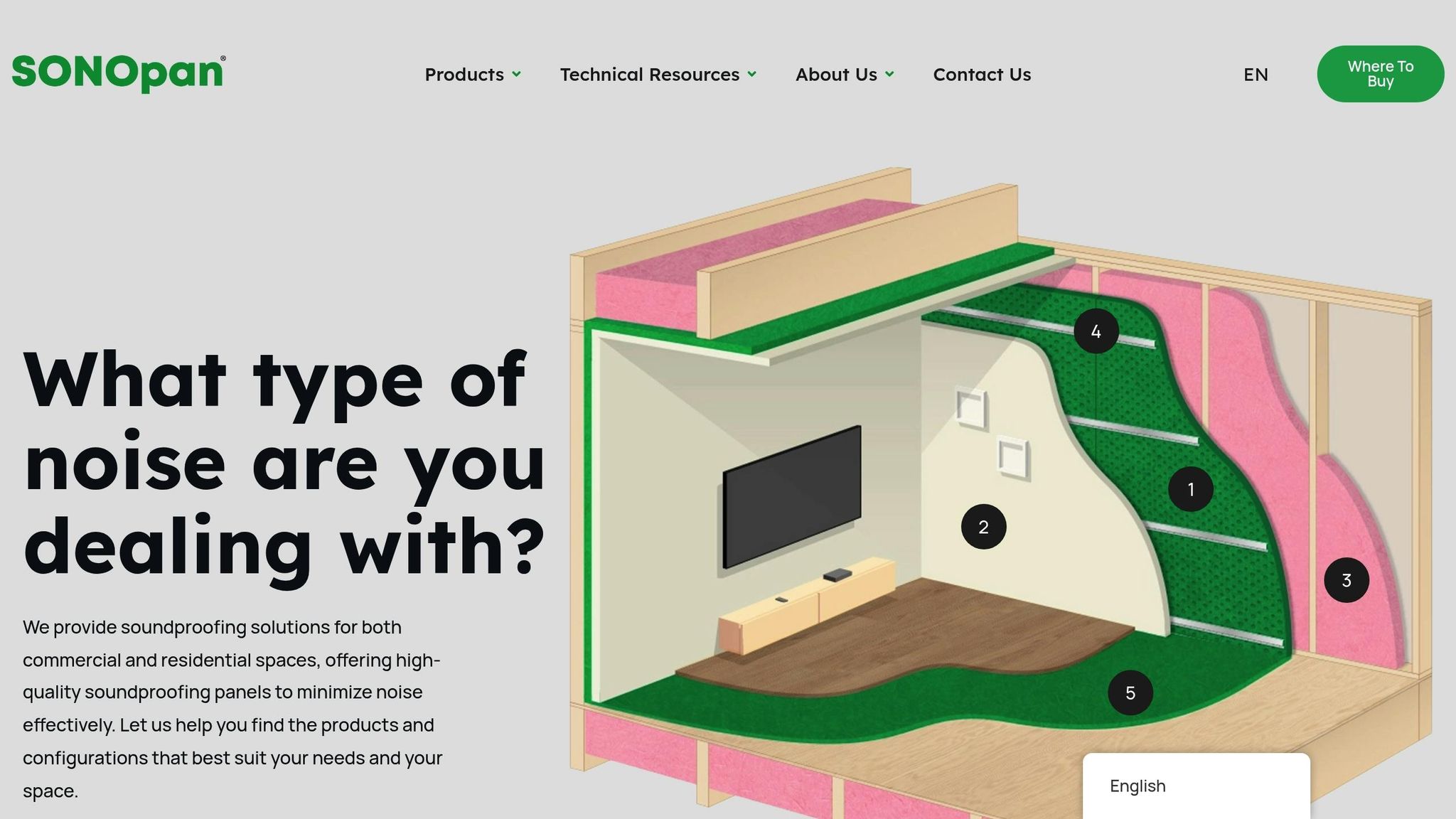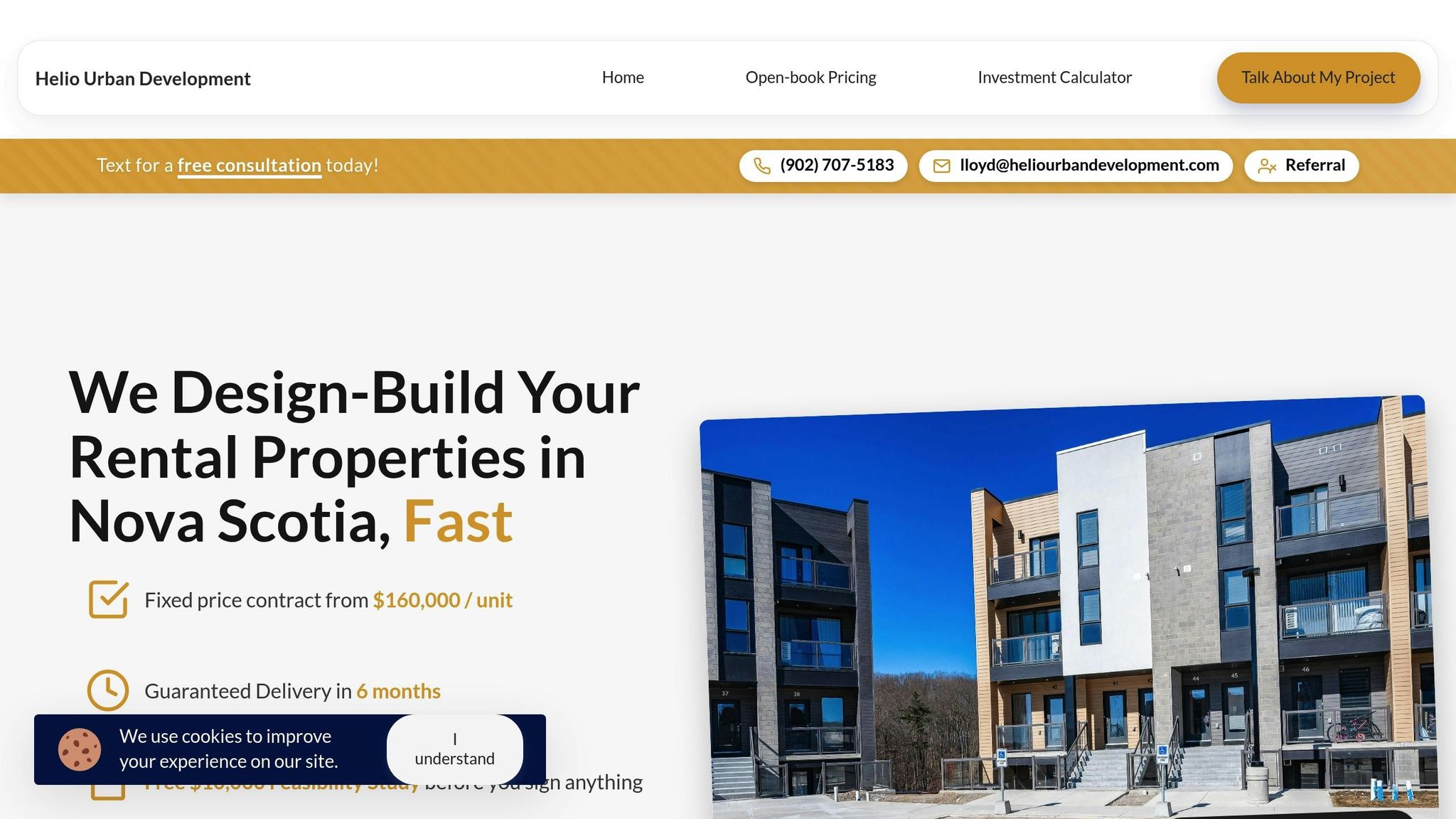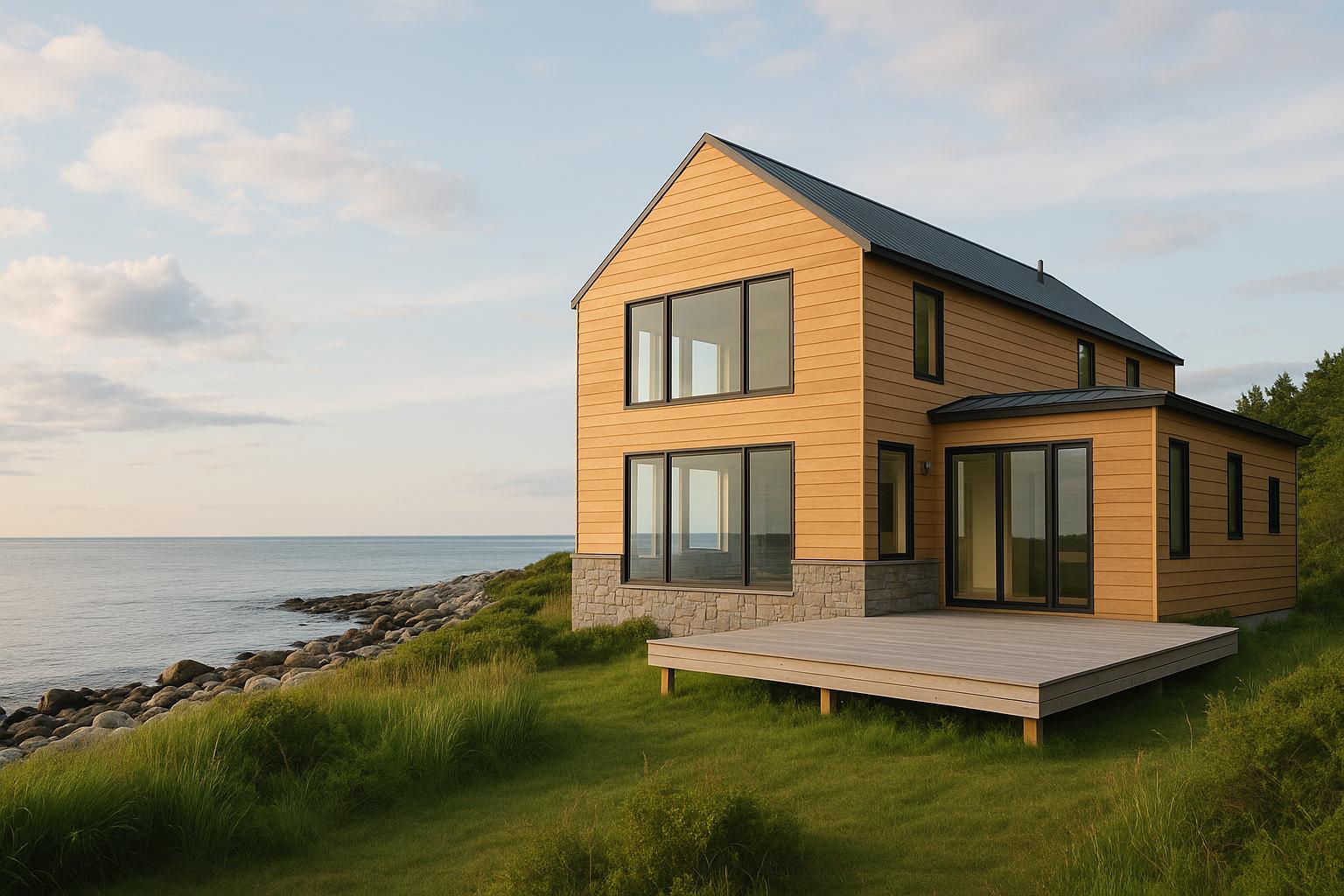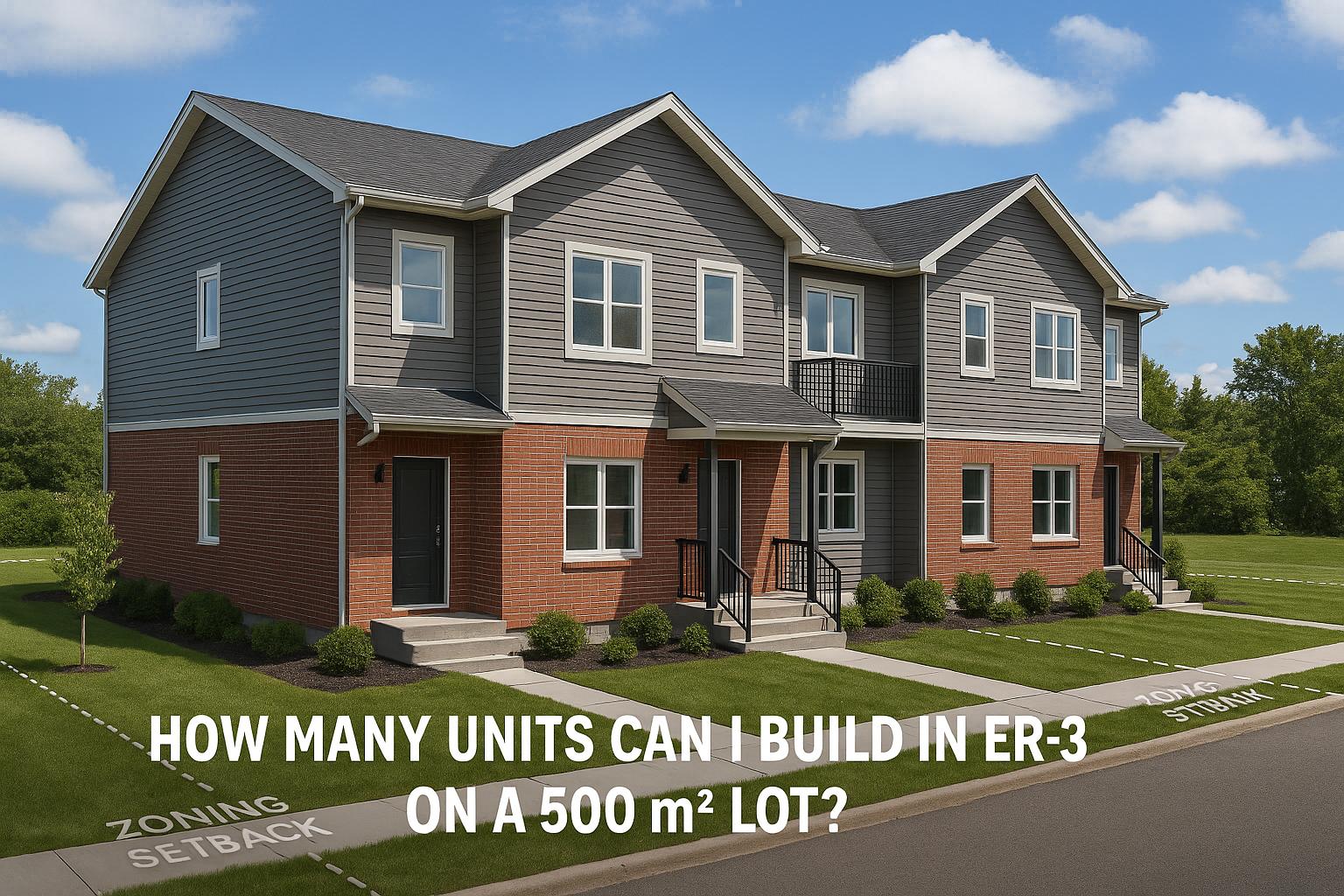Tenant complaints about noise are a major issue for rental properties in Canada, impacting retention, revenue, and property value. The challenge lies in balancing effective soundproofing with construction budgets while meeting Canada’s National Building Code standards for noise control (STC 50 for walls, IIC 50 for floors). This article reviews five soundproofing methods, ranging from basic to advanced, helping property owners choose the best solution for their needs. Key takeaways include:
- Basic Code-Minimum Assembly: Low-cost but limited noise control, leading to potential tenant dissatisfaction.
- Single-Stud with Resilient Channel: Moderately priced, improves noise isolation but requires precise installation.
- Double-Stud Systems: High-performance noise reduction, ideal for tenant comfort, but requires higher investment and space.
- Specialty Products (SONOpan, QuietRock): Effective, space-saving, and modern materials, but at a premium cost.
- Helio Urban Development’s Design-Build Model: Fixed-price ($160,000/unit) integrated approach offering superior soundproofing, faster timelines, and strong financial returns.
Quick Comparison:
| Assembly Type | Acoustic Performance | Cost | Complexity | ROI Impact | Best For |
|---|---|---|---|---|---|
| Basic Code-Minimum | Meets minimum code | Lowest | Low | Limited | Budget-conscious builds |
| Single-Stud + Resilient Channel | Improved isolation | Moderate | Medium | Moderate | Mid-market properties |
| Double-Stud System | High sound isolation | Higher | High | Strong | Premium tenant experience |
| Specialty Products | Advanced performance | Premium | Medium to High | Noticeable | Space-efficient, modern builds |
| Helio Design-Build | Superior | Fixed price | Simplified | High | High-end, multi-unit developments |
Effective soundproofing is a long-term investment that reduces complaints, increases tenant satisfaction, and enhances property value. Early planning and integrated solutions, like Helio’s design-build model, can prevent costly retrofits and ensure better results.
How to Soundproof a Wall (Budget DIY to Pro - 2025 Edition)
1. Basic Code-Minimum Assembly
A basic code-compliant soundproofing approach meets the minimum building standards for multi-unit residential buildings in Canada. These assemblies are cost-effective and provide the baseline for sound transmission performance in both walls and floors.
For party walls, the setup usually includes a simple wood stud frame filled with standard insulation, finished with drywall on both sides. The effectiveness of this assembly heavily depends on precise construction techniques and thorough air sealing.
Floor assemblies typically involve conventional floor joists paired with standard subflooring and insulation, topped off with a typical ceiling finish. Adding basic carpeting with an underlay can help reduce impact noise, but the overall acoustic performance remains limited. While these materials save on costs, they allow everyday noises - like normal conversations or louder activities - to pass between units.
This limited sound control often leads to tenant dissatisfaction, higher turnover rates, and challenges in attracting renters willing to pay premium rents. Properties with better soundproofing generally stand out in competitive rental markets. Proper air sealing is especially important, as gaps around service penetrations can further compromise acoustic performance.
Although these assemblies are budget-friendly during initial construction, retrofitting soundproofing later can become significantly more expensive. Incorporating effective measures from the start is often more economical in the long run.
2. Single-Stud Assembly with Resilient Channel and Acoustic Insulation
A single-stud assembly paired with resilient channels offers an efficient way to boost sound isolation without overhauling the entire building structure. It's a budget-friendly solution that balances performance and practicality.
Resilient channels work by decoupling the drywall from the framing, breaking the direct path that sound vibrations usually follow. This interruption significantly reduces the transfer of acoustic energy between spaces.
For this setup, use 2x4 or 2x6 studs with cavities filled with acoustic insulation specifically designed to absorb sound. The drywall is then mounted onto the resilient channels, ensuring it stays separate from the framing to maintain sound isolation.
When it comes to floor systems, resilient channels should be installed perpendicular to the joists on the ceiling side. They support the ceiling drywall while keeping it isolated from the floor above. To tackle impact noises - like footsteps or dropped objects - an acoustic underlayment is a must. However, the effectiveness of this system depends heavily on proper installation.
Mistakes, like screws piercing the resilient channel, can create rigid connections that undermine the soundproofing. Similarly, attention to detail around areas like electrical boxes and other penetrations is crucial to preserve the system's integrity.
This assembly is ideal for mid-market rental properties, offering tenants a more comfortable living experience without breaking the bank. While resilient channels and insulation excel at reducing mid- and high-frequency sounds - such as conversations and footsteps - low-frequency noises may need extra measures to be fully addressed.
3. Double-Stud Wall and Floor Systems with Acoustic Insulation
If you're looking for better soundproofing than single-stud methods can offer, double-stud assemblies are a solid choice. These systems use two separate stud walls with a gap in between, which is filled with insulation. This setup creates a barrier that significantly reduces sound transmission. Another option is the staggered-stud design, where the framing members are offset so that the finish materials don’t share the same studs. This clever approach helps block both airborne and impact noise.
Double-stud assemblies are especially good at improving Sound Transmission Class (STC) ratings compared to standard single-stud walls. The same concept applies to floors - using separated joists, insulation, and the right underlayment can noticeably improve Impact Insulation Class (IIC) ratings.
That said, these systems do require more materials, extra labour, and careful attention to detail. For example, rigid connections like electrical boxes or other penetrations need to be managed carefully to maintain the system’s effectiveness. Plus, the added thickness of double-stud walls can eat into available space.
While the upfront costs are higher, double-stud systems can be a worthwhile investment, particularly in rental properties where tenant comfort is a priority. They’re especially effective for party walls, offering superior sound isolation that protects privacy and reduces noise complaints. Though more expensive, this approach raises the bar for soundproofing when compared to other specialized solutions.
sbb-itb-16b8a48
4. Specialty Product Assemblies (SONOpan, High-Density Drywall)

When standard soundproofing methods don't quite meet the mark, specialty products like SONOpan and high-density drywall step in to provide better acoustic control. These materials are specifically designed to enhance soundproofing and can make a noticeable difference when used correctly.
SONOpan is a wood fibre panel engineered for both structural support and sound dampening. It can be installed over existing drywall or as a base layer in new builds, improving soundproofing without adding much thickness. For even better results, applying SONOpan to both sides of a wall increases the Sound Transmission Class (STC) rating significantly, without the need for complex double-stud construction.
High-density drywall options, such as QuietRock or SilentFX, take a different approach. These boards are made with multiple layers of gypsum and viscoelastic polymers, which transform sound energy into heat. A single sheet of these products can often replace several layers of standard drywall, delivering impressive acoustic benefits. On floors, specialty underlayments, like acoustic cork or rubber-based materials, can further reduce impact noise and improve Impact Insulation Class (IIC) ratings.
Installation of these products is generally straightforward, but precision matters. For example, SONOpan requires specific fastening patterns and proper joint treatments to maintain its soundproofing properties. Similarly, high-density drywall products must be handled and fastened according to the manufacturer's guidelines to achieve the best results.
These specialty products strike a balance between cost and performance, offering a more accessible solution compared to labour-intensive methods like double-stud walls. For floors, using acoustic underlayments provides an effective way to cut down on impact noise with a modest investment. However, achieving optimal soundproofing still requires attention to detail - such as proper air sealing, addressing flanking paths, and carefully integrating these materials into the overall building design.
5. Helio Urban Development Integrated Design-Build Assembly

Managing multiple contracts is often a nightmare for property owners, but Helio Urban Development has taken a completely different approach. As the only integrated design-build company in Nova Scotia specializing in rental properties with 4 or more units, Helio simplifies the process by combining planners, architects, engineers, and construction teams into a single, cohesive company. This eliminates the finger-pointing and coordination headaches that plague traditional construction methods.
With Helio's integrated design-build system, accountability is streamlined. Traditional methods often leave property owners juggling multiple contracts and dealing with uncoordinated teams, which can lead to cost overruns averaging 30–60% above initial estimates. Helio’s model eliminates these inefficiencies by operating as one unified team, ensuring clear communication and accountability at every stage.
Helio’s commitment to precision is evident in their approach to soundproofing. Instead of leaving acoustic performance to chance or dealing with issues after drywall is installed, their design team works hand-in-hand with construction crews from the very beginning. This ensures that key elements like resilient channels, properly installed acoustic insulation, and meticulous air sealing are integrated into the process - not treated as afterthoughts.
Their fixed-price model further sets them apart. At $160,000 per unit, the price includes complete soundproofing, removing the risk of unexpected cost increases. Property owners know exactly what they’re paying upfront, and Helio absorbs any additional costs - unlike traditional construction, where acoustic upgrades often turn into expensive mid-project change orders.
Timeline guarantees are another standout feature. While most projects drag on for 12–18 months, Helio guarantees completion in just 6 months. If they miss this deadline, they pay penalties of up to $1,000 per day. Achieving this rapid turnaround requires flawless coordination, particularly for soundproofing installation, which is seamlessly integrated with other trades - a feat that’s only possible when everyone is part of the same company, working toward the same goal.
To maintain high standards, Helio implements rigorous quality checks. Each project undergoes five separate engineer inspections to ensure soundproofing meets specifications before moving forward. Property owners also receive daily photo updates to track progress and can select their own final inspector, offering a level of transparency rarely seen in traditional construction.
This integrated approach doesn’t just simplify the building process - it also boosts financial returns. For properties within 90 minutes of Halifax, Helio delivers rental units that command monthly rents of $1,950–$2,100, with annual returns of 12–20%. These impressive numbers are closely tied to tenant satisfaction, particularly when it comes to the acoustic comfort between units - a detail that Helio prioritizes from the ground up.
Pros and Cons Comparison
To provide a clearer perspective on the assemblies discussed earlier, the table below highlights key differences in performance, cost, and practicality. Choosing the right soundproofing system is a balancing act between acoustic quality, budget, and ease of installation - all of which influence tenant comfort and overall returns.
| Assembly Type | Acoustic Performance | Relative Cost | Installation Complexity | ROI Impact | Key Advantages | Main Drawbacks |
|---|---|---|---|---|---|---|
| Basic Code-Minimum | Meets minimum code requirements | Lowest upfront cost | Low | Limited overall benefit | Satisfies legal standards | Minimal noise control, which could lower tenant satisfaction |
| Single-Stud with Resilient Channel | Better sound isolation than basic methods | Moderately higher than code-minimum | Medium – requires skilled installation | Moderate improvement | Strikes a balance between cost and performance | Requires precision; potential issues like thermal bridging |
| Double-Stud System | High sound isolation | Higher upfront investment | High – requires careful coordination | Strong positive impact | Outstanding noise reduction with minimal flanking noise | Higher material costs and potential space loss |
| Specialty Products | Advanced performance with modern materials | Premium pricing | Medium to high | Noticeable benefits | Space-efficient design using cutting-edge technology | Higher costs and limited contractor familiarity |
| Helio Integrated Design-Build | Superior acoustic performance | Fixed price: $160,000 per unit | Managed through integrated design-build | Maximizes project returns | Fixed price, guaranteed timeline, and streamlined installation for projects near Halifax | Higher upfront investment |
While saving on upfront costs might seem appealing, it can lead to compromises in comfort and increased maintenance down the road. This makes it essential to align the complexity of the system with the project’s overarching goals.
Basic assemblies are straightforward but may fall short in tenant satisfaction. Systems like resilient-channel or double-stud require precise execution to perform effectively, while specialty products can push timelines due to their complexity and contractor learning curves. However, an integrated design-build approach, such as Helio’s, helps mitigate delays and ensures accountability by streamlining the entire process.
Over time, advanced systems tend to retain their acoustic performance better, making them an attractive option for properties aiming to stand out in a competitive rental market. The decision ultimately comes down to balancing installation demands with the long-term benefits each system provides.
Conclusion
Selecting the right soundproofing solution for a multi-unit rental property involves weighing upfront expenses against long-term benefits. While opting for code-minimum assemblies might seem cost-effective initially, they often lead to tenant complaints that can negatively impact the property's overall performance.
Our findings highlight that successful acoustic outcomes hinge on early collaboration among architects, builders, and consultants. Planning and integrating soundproofing assemblies during the initial design phase is essential to avoid costly adjustments later and to ensure a more comfortable living environment for tenants [1].
Relying on separate contractors for design, engineering, and construction can create coordination issues that may compromise acoustic quality. An integrated design-build approach offers a clear advantage here. For example, Helio Urban Development's fixed-price model of $160,000 per unit combines acoustic design, engineering, and construction under one roof, removing uncertainties. With 31 units currently under construction and a guaranteed six-month timeline, this streamlined method ensures acoustic assemblies are seamlessly coordinated from the outset. Not only does this improve soundproofing, but it also enhances the overall success of the project.
Delaying soundproofing decisions can lead to higher construction costs, more tenant complaints, and lower rental income - issues that could have been avoided with proper planning from the start.
FAQs
What are the long-term advantages of using advanced soundproofing over basic code-minimum assemblies?
Choosing advanced soundproofing techniques instead of sticking to basic code-minimum standards can pay off in the long run. Better noise control means happier tenants, which often leads to higher retention rates and fewer turnovers - saving you time and money. Plus, with fewer noise complaints to manage, both tenants and property owners can enjoy a smoother, more positive living experience.
Opting for higher-quality soundproofing can also increase your property's appeal and market value. In competitive rental markets, offering superior acoustic comfort helps your units stand out, attracting tenants who value peace and privacy. Over time, these advantages can lead to stronger returns, making the initial investment worthwhile.
How does Helio Urban Development's design-build approach deliver superior soundproofing and project results compared to traditional methods?
Helio Urban Development simplifies the construction process with its integrated design-build model, bringing design and construction together under a single, accountable team. This approach ensures that soundproofing elements like resilient channels, acoustic insulation, and underlayment options are thoughtfully incorporated right from the start. The result? Fewer errors, smoother workflows, and fewer delays.
Traditional construction often involves juggling multiple contractors, which can lead to miscommunication and inefficiencies. Helio’s method focuses on collaboration and precision, delivering better acoustic performance for tenant comfort while keeping costs predictable and aligned with your budget. By offering tailored solutions, we help property owners achieve effective soundproofing without compromising on their return on investment.
What should property owners consider when selecting soundproofing solutions for multi-unit rental properties?
When choosing soundproofing options, property owners need to prioritise tenant comfort, budget-friendly choices, and a strong long-term return on investment (ROI). The effectiveness of these solutions often depends on a few key aspects: the materials used (like acoustic insulation or underlayments), the construction methods employed (such as resilient channels), and the overall design of the assembly. Together, these elements help achieve effective noise reduction while staying within financial limits.
Additionally, it’s crucial to consider how well these solutions strike a balance between performance and affordability. This is especially important for multi-unit rental properties, where meeting the specific needs of tenants in the Canadian market can make a big difference.
Related Blog Posts
- Materials for 4–6 Storeys in HR-1 (HR1): Light-Wood vs Mass Timber vs Hybrid
- Halifax Apartment Builder Pricing: Light-Wood vs Mass Timber, Where Costs Move
- HR-1 (HR1) Builder Halifax: The Design Moves That Calm Neighbour Concerns
- Acoustic Comfort in Small Multi‑Units: STC/IIC Targets and Assemblies for NS



